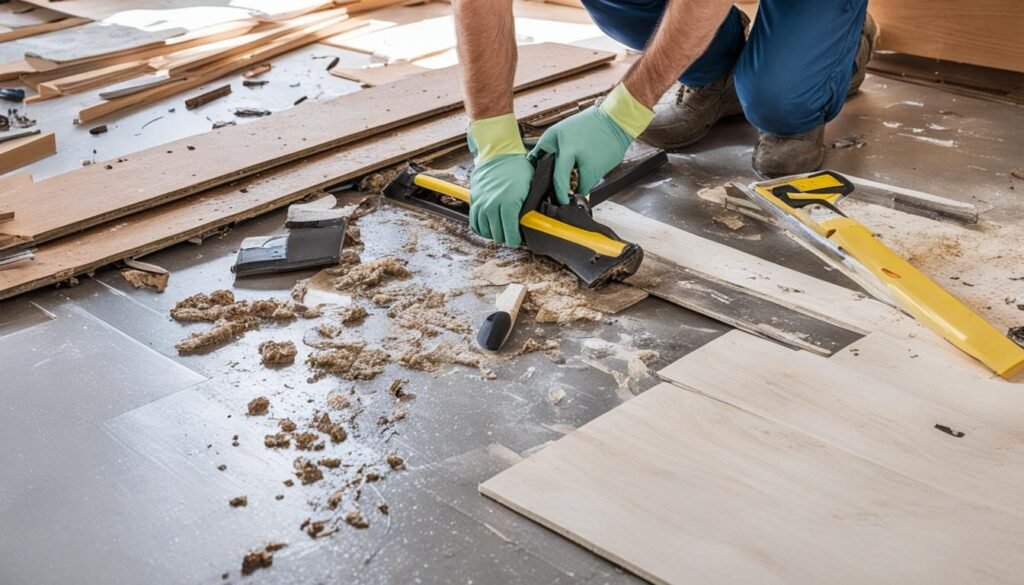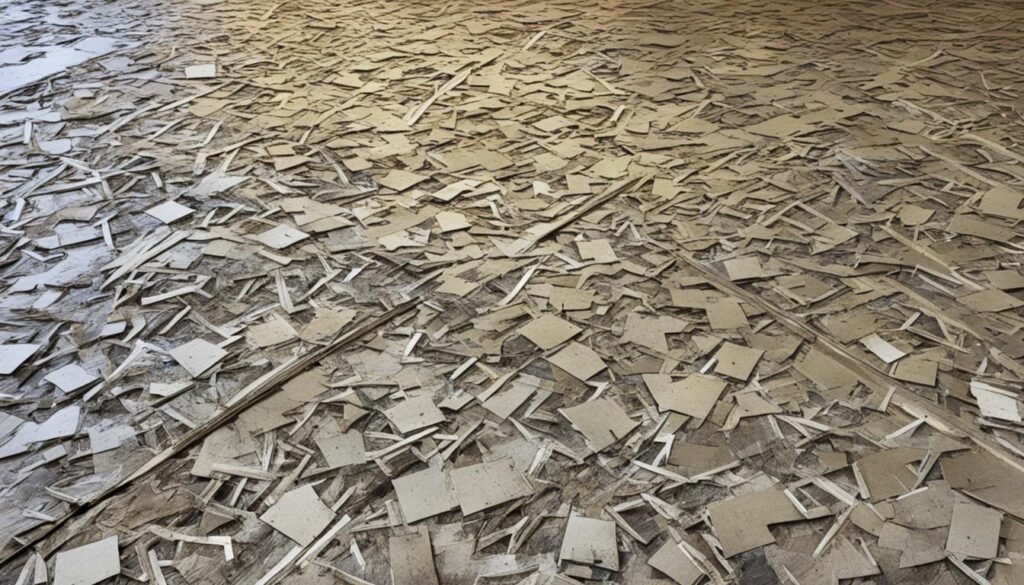Did you know water damage is a big problem for homes in the U.S., making up nearly 40% of insurance claims? Slow leaks from appliances or plumbing can hurt your subflooring a lot. This might mean you need to fix or replace it. As a pro, you know it’s key to fix this fast and right to stop more damage and save on big fixes later.
Key Takeaways
- Water damage is a common and costly problem for homeowners, accounting for nearly 40% of all home insurance claims.
- Slow leaks from appliances or plumbing issues can lead to significant damage to your subflooring, requiring extensive repairs or replacement.
- Addressing subfloor water damage quickly is crucial to prevent further damage and costly renovations.
- This step-by-step guide will provide you with the necessary information to effectively repair water-damaged subflooring.
- By following the proper techniques, you can help your clients restore their home and prevent future issues related to moisture and water infiltration.
This guide will show you how to fix water damaged subflooring step by step. It covers from spotting the issue to fixing the cause and making the subfloor as good as new. Whether it’s a small leak or big water damage, you’ll learn the right ways to fix it. This will help you avoid more problems later.
Identifying and Addressing Subfloor Water Damage
Keeping your home healthy means spotting and fixing subfloor water damage fast. Water can make the subfloor rot and need quick action. Knowing the signs and causes helps you fix your subfloor and stop more damage.
Signs of Water Damaged Subflooring
A spongy or bouncy feel underfoot is a clear sign of water-damaged subflooring. Other signs include:
- Warping or cupping in hardwood floors
- Loose or crumbling sections in tile flooring
- Bubbling, peeling, or lifting in linoleum or laminate flooring
- A musty odor, indicating the presence of mold or mildew
Common Causes of Subfloor Water Infiltration
Water damage to the subfloor can come from many sources, such as:
- Flooding from severe storms or natural disasters
- Burst pipes or plumbing leaks
- Appliance malfunctions, such as a leaking washing machine or dishwasher
- Excessive moisture or humidity in the home
Fixing the water issue first is key before working on the subfloor. It’s important to find and fix the leak or moisture source. This stops more subfloor damage.
“Addressing the initial water issue is the first step before tackling the subfloor damage. Identifying and repairing the source of the leak or moisture problem is crucial to prevent further deterioration of the subflooring.”
Stay alert and act fast on water damaged subflooring signs. This can reduce damage and save on repairs or replacements. Knowing why subfloor water infiltration happens helps you protect your home and keep your floors strong.
How to Repair Water Damaged Subflooring
Fixing a water-damaged subfloor needs a step-by-step plan. This ensures you tackle the problems and stop them from happening again. Whether it’s moisture or a full flood, the repair steps are key.
First, find and fix the water leak. This could mean fixing plumbing, sealing a roof leak, or solving other water issues. Once the leak is stopped, inspect the subfloor closely.
- Remove the top flooring, like hardwood, tile, or carpet, to see the subfloor.
- Look for water damage signs, like warping, rot, or mold. If the subfloor is badly damaged, remove those parts.
- Use a utility knife or saw to cut out and remove the damaged subfloor sections.
- Check and strengthen the floor joists for a solid base for the new subfloor.
- Cut and install new plywood to replace the damaged subfloor sections.
- Attach the new plywood subfloor to the joists with screws or nails, as the manufacturer suggests.
- Put back the top flooring, making sure the surface is ready and installed correctly.
These steps help fix a water-damaged subfloor and stop future problems. Always work safely, wear the right gear, and get help if the damage is big or you’re not sure what to do next.
| Subfloor Repair Checklist | Key Steps |
|---|---|
| 1. Stop the water source | Identify and fix the root cause of the water infiltration |
| 2. Remove the top flooring | Expose the subfloor for a thorough inspection |
| 3. Cut out damaged sections | Remove all deteriorated areas of the subfloor |
| 4. Reinforce floor joists | Ensure a strong foundation for the new subfloor |
| 5. Install new plywood subfloor | Securely fasten the replacement subfloor to the joists |
| 6. Replace top flooring | Properly prepare the surface and follow installation guidelines |
By following these steps, you can fix a water-damaged subfloor and avoid future problems. Always work safely, wear the right gear, and get help if the damage is big or you’re not sure what to do next.

Fixing subfloor water issues and making your flooring system strong is key for a safe and useful home. With the right steps and care, you can repair water-damaged subflooring. This ensures a strong, lasting foundation for your home.
Conclusion
Fixing water damage to your home’s subfloor is key to keeping your property strong. It’s important to act fast and fix any water issues. This way, you stop more problems and keep your investment safe.
FloodFixers is here to help homeowners in Moreno Valley, CA with top-notch water damage repair and subfloor restoration. They have the skills and dedication to make sure your subfloor is fixed right. This means your home will be stable and safe for a long time.
Don’t let water damage get worse – act now. Working with FloodFixers means your property is in expert hands. Your investment will be safe for many years.


